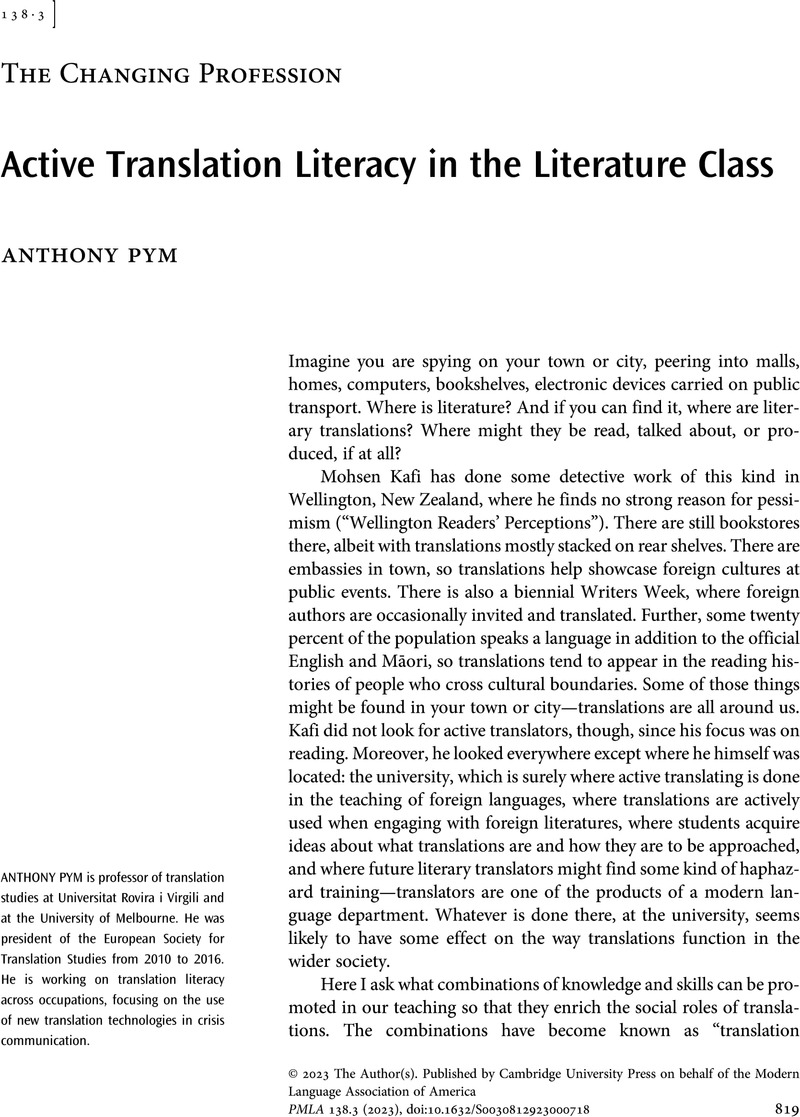No CrossRef data available.
Article contents
Active Translation Literacy in the Literature Class
Published online by Cambridge University Press: 12 September 2023
Abstract
An abstract is not available for this content so a preview has been provided. Please use the Get access link above for information on how to access this content.

Information
- Type
- The Changing Profession
- Information
- Copyright
- Copyright © 2023 The Author(s). Published by Cambridge University Press on behalf of the Modern Language Association of America
References
Works Cited
Baer, Brian James. “Is There a Translation in This Class? A Crash Course in Translation Literacy.” Teaching Translation: Pedagogical Contexts and Reading Practices, edited by Baer, Michelle Woods, , Taylor and Francis, 2023, pp. 3–12.Google Scholar
Bowker, Lynne, and Ciro, Jairo Buitrago. Machine Translation and Global Research: Towards Improved Machine Translation Literacy in the Scholarly Community. Emerald Publishing, 2019.Google Scholar
Gaddis Rose, Marilyn. Translation and Literary Criticism: Translation as Analysis. St. Jerome Publishing, 1997.Google Scholar
Hadley, James Luke, et al., editors. Using Technologies for Creative-Text Translation. Routledge, 2022.CrossRefGoogle Scholar
Hassan, Hany, et al. “Achieving Human Parity on Automatic Chinese to English News Translation.” Microsoft, 2018, www.microsoft.com/en-us/research/uploads/prod/2018/03/final-achieving-human.pdf.Google Scholar
Kafi, Mohsen. The Selection, Promotion, and Reception of Translated Fiction in Wellington. 2022. U of Wellington, PhD dissertation.CrossRefGoogle Scholar
Kafi, Mohsen. “Wellington Readers’ Perceptions of Translated Fiction: A Survey-Based Study.” Translating and Interpreting in Australia and New Zealand: Distance and Diversity, edited by Wakabayashi, Judy and O'Hagan, Minako, Taylor and Francis, 2021, pp. 268–88.CrossRefGoogle Scholar
Klitgård, Ida. “Calling for Translation Literacy: The Use of Covert Translation in Student Academic Writing in Higher Education.” Translation and Translanguaging in Multilingual Contexts, vol. 4, no. 2, 2018, pp. 306–23.CrossRefGoogle Scholar
Läubli, Samuel, et al. “Has Machine Translation Achieved Human Parity? A Case for Document-Level Evaluation.” Arxiv, 2018, arxiv.org/pdf/1808.07048.pdf.CrossRefGoogle Scholar
Xun, Lu and Qu Qiubai. “Qu Qiubai and Lu Xun: An Exchange on Translation.” Translated by Estep, Chloe. The Translation Studies Reader, 4th ed., edited by Venuti, Lawrence, Routledge, 2021, pp. 106–21.Google Scholar
Pym, Anthony. Translation Solutions for Many Languages: Histories of a Flawed Dream. Bloomsbury, 2016.Google Scholar
Takeda, Kayoko, and Yamada, Masaru. “‘TI Literacy’ for General Undergraduate Education.” The Evolving Curriculum in Interpreter and Translator Education: Stakeholder Perspectives and Voices, edited by Sawyer, David B. et al., John Benjamins Publishing, 2019, pp. 53–74.CrossRefGoogle Scholar
Toury, Gideon. “‘Everything Has Its Price’: An Alternative to Normative Conditioning in Translator Training.” Interface: Journal of Applied Linguistics, vol. 6, no. 2, 1992, pp. 60–72.Google Scholar

